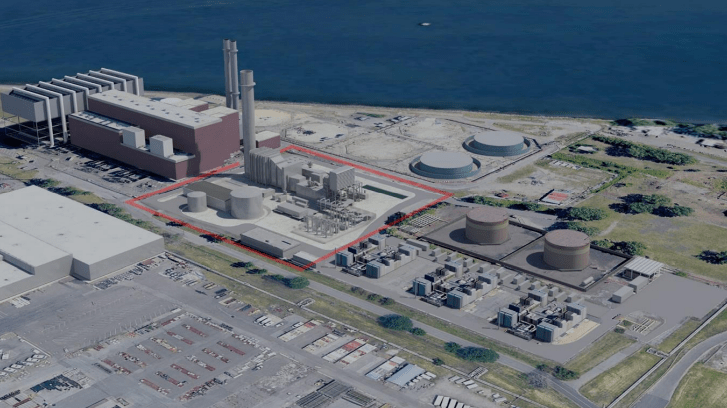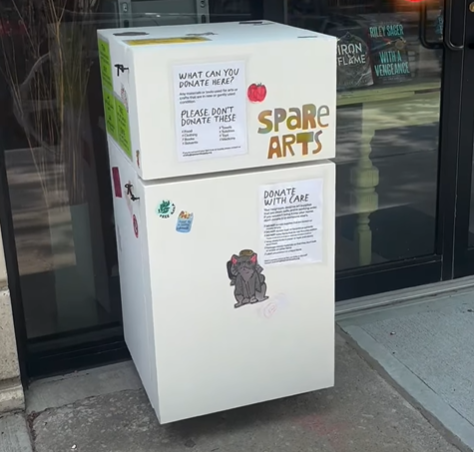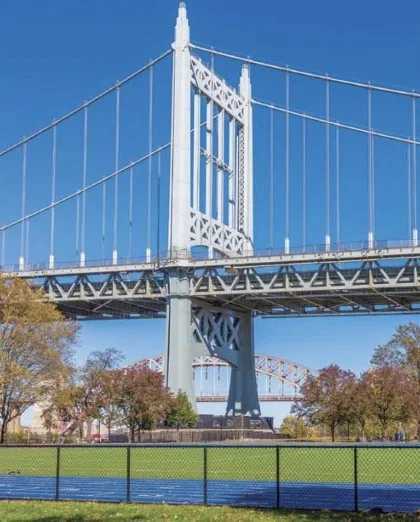Astoria’s elected officials and community climate activists voiced staunch opposition to NRG’s Astoria Replacement Project, while business and labor union groups shared their support of said project, during a virtual public meeting hosted by the energy company in January.
NRG representatives gave an overview of the Astoria Replacement Project, which is meant to replace the 50-year old power plant located at 31-01 20th Ave., during the virtual meeting on Thursday, Jan. 21.
Tom Atkins, vice president of development at NRG, led the presentation. He explained NRG has provided power to New York City for decades. They have operated a 15-acre gas turbines site in northern Astoria since 1999, after acquiring it from Con Edison, which operates the larger 300-acre complex in the area.
The site was designed to provide peaking services, contingency support and system restoration service. The plant is meant to provide back-up or stand-by power when the city’s system load is at its maximum, whether that’s due to extreme hot or cold temperatures, a strong storm or a major generator shutting down.
In 2010, NRG proposed a 1,040 megawatt project to replace the existing generators. While that proposal was reviewed and approved, NRG didn’t pursue it, citing “prevailing market conditions.”
Now, NRG is proposing the project stays as a peaking facility with a new state-of-the-art unit capable of generating 437 megawatts.
Atkins said they modernized the technology to be “the latest and greatest” gas turbine on the market today. He said they already selected General Electric to supply the generator, which will be manufactured in Schenectady.
Atkins said that since half of the site will be used in the new proposal, NRG is considering using the other half for standalone battery storage projects.
He added that the new proposal is more in-line with New York’s climate agenda, and that it could be converted to zero-carbon fuel in the future.
“The updated project provides immediate clean air benefits, due to the use of modern pollution control technology, the replacement project will result in up to a 99 percent reduction in air emission rates, that’s compared to the existing units,” Atkains said. “Also, due to the greater efficiency of the new generator, carbon dioxide emissions will be reduced by 34 percent.”
Atkins said that a report by an independent consultant company, Guidehouse Consulting, found their proposal would result in nearly five million tons of cumulative greenhouse gas emissions reductions through the year 2035, the equivalent of taking 84,500 cars off the road (or 12 percent of all registered cars in Queens).
Another report by the consultant company that focused on the economic benefits of building and operating NRG’s proposal found the project would result in 500 new jobs during construction, and $156 million in economic benefits for the state. Atkins said construction jobs would be filled by union labor.
In terms of operating the site, the report found they’d create about 73 jobs per year, which would result in $170 million in economic benefits through 2040. Atkins said union labor groups would operate the site, as they do now.
The report also found the project would lower electricity costs for customers by more than $1.3 billion over the first five years of operation.
The project as a whole will cost $350 million. Atkins said the project will be funded by private capital, with no obligation to taxpayers or ratepayers.
NRG commissioned The Harris Poll to conduct an online survey (from Sept. 18 to Oct. 1, 2020) that found three-quarters of the 1,242 respondents support their project.
The poll found that 56 percent of respondents want to focus on renewable energy and other technology, including natural gas, while 26 percent argue for an energy strategy that is exclusively 100 percent renewable. It also found 68 percent of respondents support relying more on natural gas in order to reduce air pollution, while only 27 percent said the state should wait for 100 percent renewable technology.
More than 200 individuals participated in the three-hour-long meeting that night.
During the question and answer portion, all of Astoria’s elected officials, who have previously expressed their opposition to the project, questioned NRG’s proposal as it stands.
Assemblyman Zohran Mamdani asked about jobs, noting the 500 construction jobs may only last one to two years.
“We’re constantly told that the jobs this plant will bring has to be considered when critiquing its environmental impact,” Mamdani said. “Why should Queens even consider choking itself on NRG’s pollution for economic benefits that are either temporary, or it’s such a limited scale?”
Atkins said the jobs, although not long-term, will be high value, adding that the alternative would be that the existing plant “continues to run.”
But Joe Stanton, a member of the DSA’s Ecosocialist Working Group, one of the groups organizing against the proposed project, noted that their current facility in Astoria is mandated to close by 2023.
Atkins admitted that NRG’s existing turbines are impacted by the New York State Department of Environmental Conservation (DEC)’s NOx rule, meant to phase out peaker plants and improve air quality.
He said that’s why NRG plans to “retire” the existing turbines in May 2023 and replace them, but that Con Edison ultimately has the capability to determine whether they need to keep the existing equipment because of “reliability reasons.”
State Senator Michael Gianaris noted that while NRG’s presentation mentioned their technology could be converted to hydrogen in the future, it “seems short of a commitment.” Gianaris said there are many “temporary peakers” in Long Island City that were installed in an emergency basis that were to be removed within two years, but are still there 20 years later.
When he asked for a concrete commitment, Atkins said the project will commit to the terms of the Climate Leadership and Community Protection Act (CLCPA), a 2019-implemented law that establishes a framework for New York to fully reduce greenhouse gas emissions and commit to clean energy.
“To the extent that we reach the year 2040, and we’re not able to convert to zero carbon fuel, then per the terms of the existing CLCPA, we will have to shut the plant down,” Atkins said. “That is our commitment to you.”
State Senator Jessica Ramos said “as long as fossil fuels are being burned in our community, this project is going to remain unacceptable for us, union jobs or not.” She also said NRG is not in compliance with the CLCPA.
Ramos added that she’s asked for an enhanced public review process from the state. Some community members have expressed concerns about NRG bypassing a public review process due to the approval of their 2010 proposal.
Atkins said that they agree with the state and country’s move from fossil fuels, but said that in the transition period, “we need to have gas fired units to provide backup service until at least 2040.”
Both City Councilman Jimmy Van Bramer and Tiffany Cabán, who is running for City Council in District 22, asked similar questions about why NRG can’t use the plant for more efficient energy or battery storage systems instead of extending the site’s life as a fossil fuel plant.
Atkins said there is currently a mobile battery storage project under construction at the Astoria site, in partnership with Con Edison. He added that they’re aware that energy storage is a “promising technology,” but that it’s “not sufficient” to currently meet the needs of the city.
But several other community members and advocates with the No Astoria NRG Fracked Gas Plant Coalition (made up of several climate advocacy groups in Queens), were not convinced that other greener avenues are being considered.
City Councilman Costa Constantinides emphasized Astoria’s high childhood asthma rates, and mentioned his own son’s asthma, after he asked why NRG is pursuing fossil fuel “when we have an opportunity to build renewable row.”
Sebastian Baez, a life-long Astoria resident and organizer with DSA, said he, too, grew up with asthma.
“I’m born and raised in Astoria. I used to play soccer right next to NRG’s current plant, and I had childhood asthma along with many of my friends,” Baez said. “For the last 20 plus years we’ve been breathing the Astoria air with fossil fuel chokeholds on our necks, and all this project does is loosen it a tiny bit. We’re still being choked. NRG is giving us a false choice between keeping the lights on and renewable energy. We know we can have both.”
Another participant called The Harris Poll, “opaque, narrow, and incomplete.”
Another participant asked whether the offshore wind farm Con Edison has committed to building in Astoria will eliminate the need for NRG’s project.
Atkins said their project “doesn’t compete with offshore wind. “It’s not offshore wind or the Astoria Replacement Project, it’s both,” he said.
Although he claimed NYSERDA’s offshore wind farm initiative won’t connect to Astoria, it actually will, along with other coasts in the city and Long Island.
Some participants weren’t pleased with the meeting’s format, which was conducted virtually via NRG’s website. Individuals had to dial in through a separate phone number if they were interested in asking a question or providing commentary. There was no video of NRG’s representatives nor the public during the meeting.
Atkins attributed that to current COVID-19 restrictions.
During the virtual meeting, more than a dozen people also spoke in favor of NRG’s proposal.
One of them was Queens Chamber of Commerce President and CEO Thomas Grech, who previously wrote an op-ed about how NRG’s Astoria plant could prevent “California-style rolling blackouts.” He reiterated that the project will bring needed jobs to Queens.
“This is a great opportunity for union jobs, to help clear the air and give an opportunity for this business to continue their efforts to reduce the carbon footprint over time,” Grech said.
Other representatives of labor unions agreed that the project will provide good paying jobs and sustain the city’s energy system.
Joe DiPietro, president of the Federation of Italian-American Organizations of Queens that runs a soccer field right next to NRG’s plant, said he is for their proposal.
“We all want clean energy,” he said. “I agree with this new project because if we don’t renew this plan, what is going to happen? We’re going to get more pollution. For the time being, I think it’s the best solution that we can have.”
In a statement, Atkins told QNS that there will be at least one additional public meeting that will be hosted by the DEC. A date and time for that meeting has yet to be announced.
“The meeting was a great opportunity to share the facts and dispel misinformation. We’re grateful for the strong community support this project has received from Astoria residents, business owners and labor leaders, many of whom joined our public meeting – a testament to the state’s open and transparent permitting process,” Atkinson said “The public has had and will continue to have the opportunity to ask questions and provide feedback. I encourage you to visit cleanerpowerforastoria.com to see an overview of the project and ways your readers can provide feedback.”
In September, more than 200 people, including the aforementioned elected officials, marched through Astoria in protest of NRG’s plans. A month following that rally, Queens Climate Project hosted a bike ride along western Queens to educate community members about the existing peaker plants in Long Island City and Astoria, where they also expressed opposition to NRG’s proposal.






































